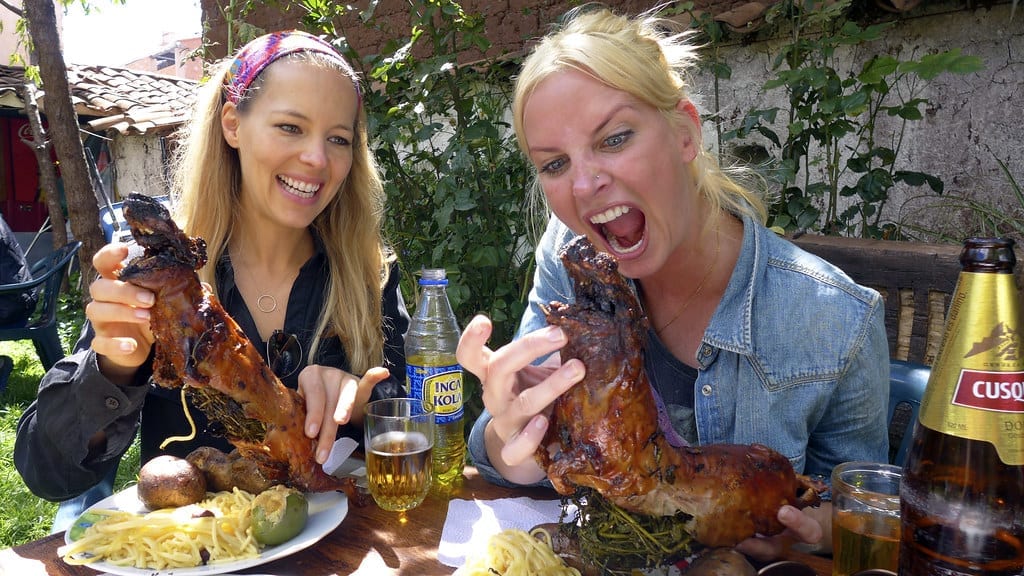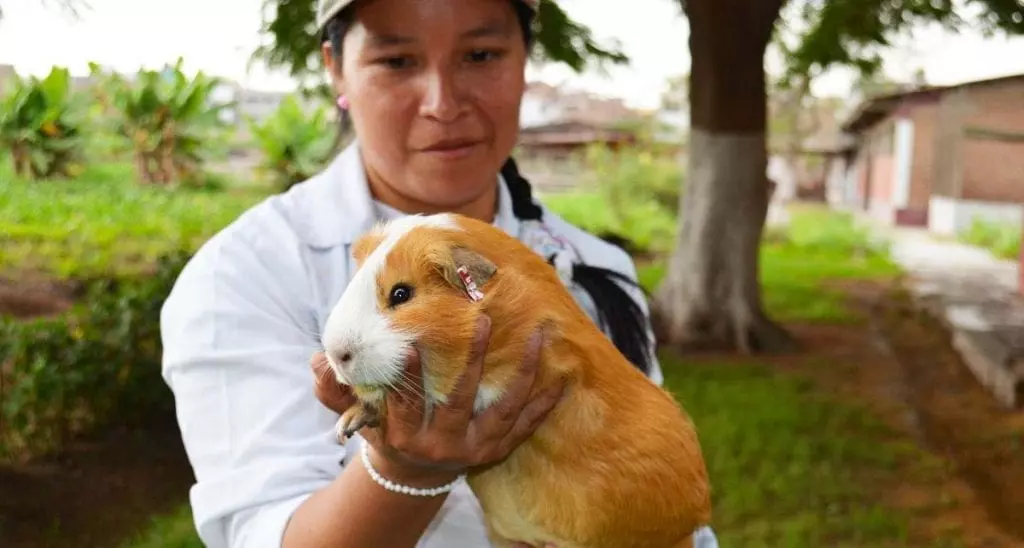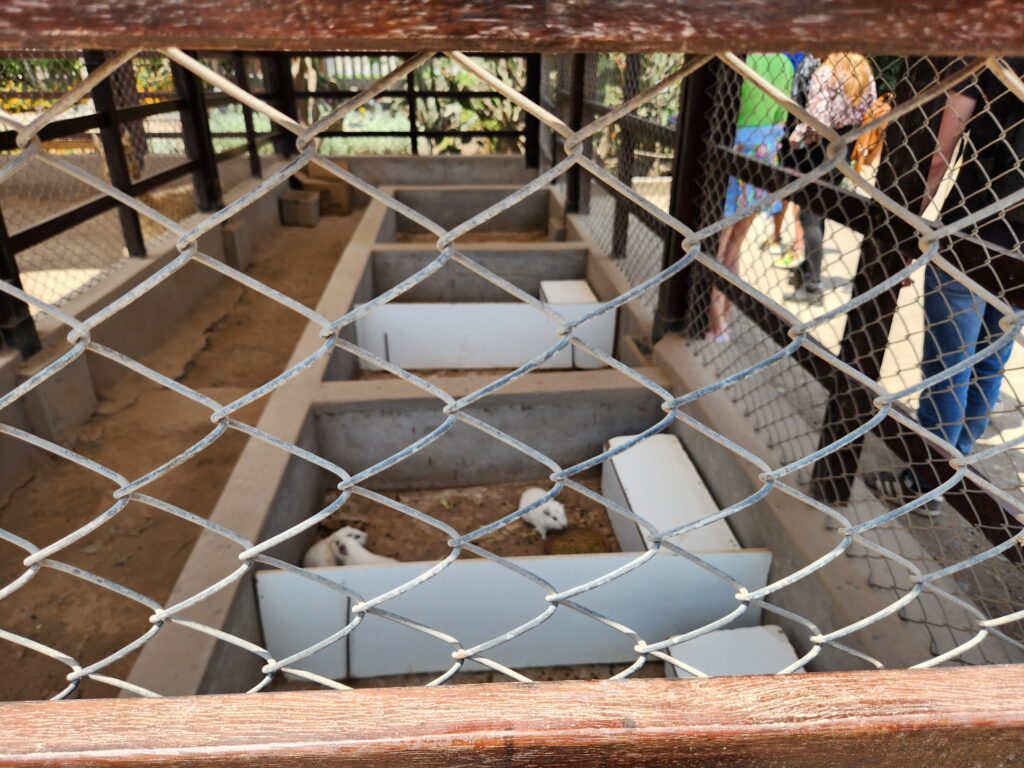The Peruvian Guinea Pig
James Bustamante is Native to New York but born to Peruvian parents. He has been traveling throughout Latin America since early 2003 and finally made his home in Peru. James has made his way by eating and traveling through almost every country in Central and South America.
Last Updated on December 7, 2023 by James Bustamante
The Peruvian guinea pig is one of nature’s cutest creations. Most people in the West keep them as pets as they easily fit in any apartment and need minimal care. However, travelers flying over to South America need to understand that things work a bit differently over here. To the highland locals, they are as important to local culture as the Machu Picchu Hike.

Now, just to set the scene, we are currently experiencing a culinary boom in Peru due in large part to our incredible variety of typical Peruvian dishes, but one tends not to receive much fanfare from international media, the Peruvian guinea pig.
These cute little rodents are increasingly showing up in the United States….and not just as pets.
Peruvian Guinea Pig Dishes
South American restaurants serve a wide variety of dishes, and Peru is no different. With dishes ranging from muy muy (tiny sand crabs) to bats and even cats in some regions,the Peruvian guinea pig forms part of the local culture and is usually cooked whole, often grilled, sometimes even deep fried and served with a plethora of side dishes.

Many diners eat every last morsel, literally from head to toe, as guinea pig bones are quite small and easy to chew. So now that you’ve taken that all in, let’s look at the history of the guinea pig or cuy as it’s called in Peru.
This delicacy has been a gastronomical symbol for many centuries, dating back to the pre-Inca civilizations. Back then only high-ranking nobles could taste this delicious dish and some were even sacrificed to their pantheon of gods.
Witchdoctors and shamans even used their intestines to take a peek into the future or even used to cure some diseases. Nowadays though, guinea pigs are raised commercially and form an important part of the Peruvian diet, reason as to why Peru has declared it part of its National Patrimony.
This furry little animal has become so important that Peru’s Ministry of Agriculture and Irrigation, MINAGRI, declared the second Friday of the month of October of each year as National Cuy (Guinea Pig) Day to promote their consumption in all of Peru.
If you plan on making your Machu Picchu reservations for October try some adventurous and taste some of the local dishes.

I know what you’re thinking, “why would I want to eat such a cute little thing?” Well, for one thing, it’s highly nutritional as it is high in protein and iron, great for people that need that extra edge at the gym.
It is also very low in fat and rich in omega-3, minerals, and vitamins. Some nutritionists even call it a super food, containing everything you need for your day and probably a bit more. You shouldn’t be scared to try something new just because of the way it looks, it’s definitely one of our favorites.
If you want to know anything more about Peru, Cusco, and Machu Picchu Travel, check out the rest of our blog posts at Peru Travel Blog, and be sure to follow us on Facebook and Instagram for our special packages.
History of The Guinea Pig or “Cuy”
Embarking on a Peru tour package promises a journey through stunning landscapes and rich history and an immersive experience into a culinary tradition that dates back over 5,000 years. In the heart of Andean cuisine lies a dish that has been an integral part of Peruvian culture long before the arrival of European colonizers with their chickens, pigs, and cows. This dish is none other than the guinea pig, known locally as ‘cuy.’
The guinea pig meat, tender and flavorsome, was a staple in the pre-colonial diet of Peru. Historical evidence suggests that the Incas, the region’s ancient civilization, domesticated guinea pigs more than five millennia ago. This culinary tradition has been so deeply ingrained in Peruvian culture that it is considered a flagship dish of the country. To truly understand and appreciate Peruvian tourism in its entirety, one must experience the taste of this unique and fantastic dish.
During the Inca period, the guinea pig was a source of nourishment and held significant cultural and religious importance. It was a dish enjoyed by the nobility and used by Inca priests in rituals for predicting the future or as offerings in sacrifices. A testament to its cultural significance is vividly illustrated in the renowned religious painting in the Cathedral of Cusco, ‘The Last Supper,’ which depicts Jesus and his disciples partaking in a meal with a boiled guinea pig as the centerpiece.
The guinea pig’s role extends beyond culinary and religious realms into the social fabric of Peru. A fascinating aspect of Peruvian culture is the ‘Tómbola de Cuyes,’ a popular gambling game. This game involves a circular area marked with numbered squares. Participants bet on the number they predict the guinea pig will enter, with correct guesses winning prizes. This game not only entertains but also reflects the deep-rooted presence of the guinea pig in Peruvian culture.
The tradition of consuming guinea pigs in Peru is also intertwined with social customs. It is customary to gift a pair of guinea pigs to newlyweds, children, or guests, not as pets, but for raising and eventually consuming, akin to how chickens are often presented at home for food. This practice symbolizes self-sufficiency and respect for local customs.
A Peru tour package offers much more than scenic vistas and historical exploration. It is a gateway to experiencing a unique culinary heritage centered around the guinea pig, a dish that encapsulates the essence of Peruvian culture and history. From its role in ancient Incan society to its presence in modern-day festivities and social customs, the guinea pig is not just a meal but a symbol of Peru’s enduring legacy. As a traveler seeking a comprehensive understanding of Peruvian culture, tasting this dish is an essential and unforgettable part of the journey.
How To Eat Guinea Pig?
When indulging in this unique dish, embracing the local customs is essential. The traditional way to enjoy guinea pigs in Peru is with your hands. This practice is not only common but is also a part of the authentic experience. You’ll notice that this is the norm when dining in local restaurants and using utensils might even draw curious glances from the locals.
It’s a practice that immerses you in the local culture and connects you with centuries-old traditions. This can be particularly true in places like the communities surrounding Cusco or the Sacred Valley.
As you venture through Peru, especially after a rewarding Machu Picchu hike, the opportunity to relax and indulge in this Peruvian delicacy should not be missed. Guinea pig is often served on special occasions, symbolizing hospitality and celebration. If you are a local family guest, being offered this dish is a sign of honor and respect. Politely accepting and trying is not just about tasting local cuisine; it’s about showing appreciation for the culture and traditions of your hosts.
The experience of eating guinea pigs in Peru is about more than just food; it’s a cultural immersion. Be prepared for a bit of a messy affair – keeping a packet of napkins at hand is advisable. This adds to the authenticity of the experience, allowing you to engage fully with the local dining customs.
I advise embracing these unique culinary experiences as part of your journey. There is no better way to engage with the local culture than through food. The guinea pig dish is not just a meal; it’s a gateway into understanding the Peruvian way of life in the Andes, their customs, and their history.
What Does Guinea Pig Taste Like?
For those trying guinea pig for the first time, you’ll find its meat comparable to a succulent chicken but with a firmer and slightly greasier consistency. This comparison often resonates with diners, including seasoned travelers and locals. However, for European visitors, the taste of guinea pig might more closely resemble that of rabbit, particularly the darker, richer meat variety. In either case, the flavor of guinea pig meat is sure to be a pleasant surprise.
One of the remarkable aspects of guinea pig meat is its nutritional profile. It is known for having a low percentage of cholesterol while being rich in protein, making it a healthier alternative to many other types of meat. This characteristic highlights the incredible biodiversity of Peru, showcasing the range of unique animals and products the country offers to locals and visitors.
Where Can I Buy Guinea Pig Meat?

For those living in Peru, you can pretty much get guinea pigs in supermarkets and street markets. It is way more common than you might think.
The guinea pig is commonly regarded as a pet in many countries, particularly in the United States and Europe. Thus, its consumption as a food source is not widely practiced or is even prohibited. However, in the Andean region, particularly in Peru, Colombia, Bolivia, and Ecuador, the guinea pig is an essential part of the culinary tradition and is widely consumed.
For those residing in countries where the guinea pig is traditionally seen as a pet, it is still possible to experience this unique aspect of Andean cuisine. Specialized meat and grill stores in some regions may offer guinea pig meat, although it is typically imported from Andean countries, where it is a common food source. This allows for a taste of the Andean culinary tradition far from its origin.
Frequently Asked Questions About Peruvian Guinea Pig
Where do Guinea Pigs Come from?
Guinea pigs first appeared along the Andes Mountain Range.
Are Peruvian Guinea Pigs caught or farmed?
Peruvian guinea pigs today come from Guinea pig farms, much like any other livestock farm only much smaller.
Are guinea pigs safe to eat?
Guinea pigs in Peru are just as safe to eat as any other dish. They are farm-raised and only feed on fruit, vegetables, and seeds.
What does a guinea pig taste like?
It really depends on how it is prepared; however, the meat does taste a bit like a fatty chicken.
Do they serve guinea pigs everywhere in Peru?
No. This is considered a specialty dish, so you have to go to a restaurant that specializes in making “Cuy”. It is much more common in the Peruvian highlands than in the coastal region.
How is the Peruvian guinea pig prepared?
There are many ways it can be prepared from a rotisserie style, baked, deep fried, stewed, and even in fried rice.


